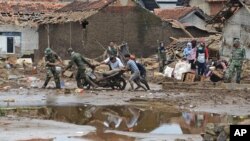Less than a week after Indonesia faced its third round of deadly landslides and flash floods this year, some local environmental advocates are saying the sheer impact of the natural disasters is the result of more than just bad weather.
At least 26 people, including an 8-month-old baby and eight children, were left dead as torrential downpours pounded the vast tropical archipelago on Wednesday. A National Disaster Management Mitigation Agency spokesperson was quick to warn of increasingly heavy rains through January, partly because of La Nina, the opposite of El Nino, which has a general cooling effect.
In the Garut district of West Java, among the hardest hit areas, where 18 people remain missing, Abetnego Tarigan, director of Friends of the Earth Indonesia, the country's largest environmental organization, says man-made factors are also putting lives at risk.
“The function of this catchment area has changed," he told VOA's Indonesia Service, describing a natural watershed area that has been subject to commercial development in recent years.
On many Indonesian islands, forested catchment areas naturally absorb rainfall and guide surface runoff toward surrounding river and shoreline areas. But when paved development projects eat up the natural landscape, Tarigan said, the water can't be absorbed as efficiently, exacerbating the impact of floods and landslides.
"It was conservation forestry, so why did it become tourist facilities, where 10 percent of its area are allowed to be developed in concrete?" he said. "For sure, all these have influenced the disaster.”
In an archipelago nation where millions of people live in mountainous areas or on flood plains near rivers, landslides and flooding are common. But so long as heavy rains persist amid unchecked development, he said, resulting death tolls are likely to increase.
The primary culprit is what Tarigan calls "nature parks for tourism," a program that pairs private companies with government agencies to build tourism facilities in dedicated conservation areas, sometimes to support commercial interests.
Agung Ganthar Kusumanto, a West Java-based environmental activist, said the entrepreneurs who pair with government agencies to conduct conservation efforts aren't assuming responsibility for the consequences of developing watershed areas.
"Where is the role of Perhutani, in protecting the forestry?" he said, referring to Perum Perhutani, a state owned enterprise that is tasked with managing national forests in Java and Madura, and oversees some national development directives.
"If we look closer, the protected forestry area has become a vegetable farm,” he said.
Dedy Kurniawan, chairman of Indonesia Conservation Cadre Communication Forum, said development directives can't simply be issued from Jakarta, but must done in concert with provincial officials if the impact of heavy rains is to be kept in check.
“Spatial planning of Garut District area must be in accordance with the policies of the province," he said. "At issue is the infrastructure development and tourism facilities, such as road openings, hotels, etc, that are being built without prioritizing environmental preservation.
"In many cases," he added, "regulations made by the provincial government are not in accordance with the program of district government and the central government institute in charge of such an area.”
If tourism development continues to disregard preservation of the natural environment, he said, officials will have no way to attract tourists in the first place.
In June, heavy rains caused massive destruction when flood waters carried mud and rocks into Central Java province, the most populous region on the island, killing almost 50 people.
In May, 15 students on holiday at a popular tourist spot in western Indonesia were killed when a landslide swept through their campground.
This report was produced in collaboration with VOA's Indonesia Service. Some information is from AP and AFP.






